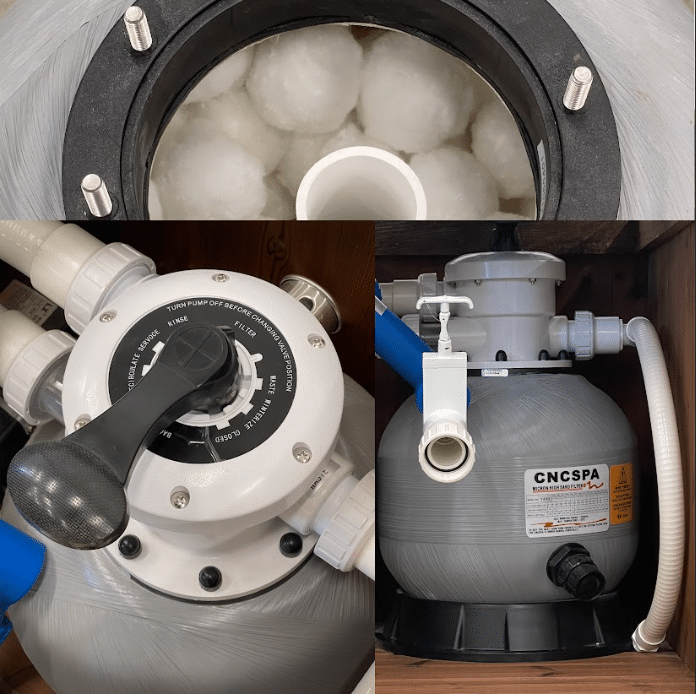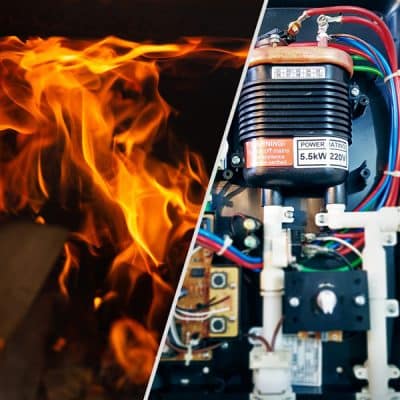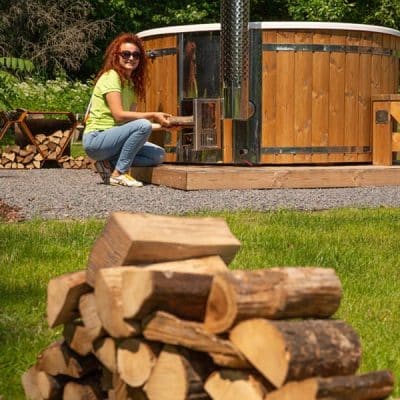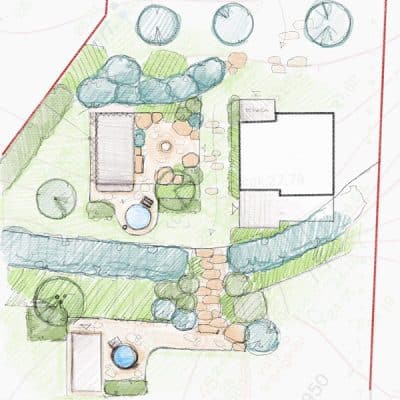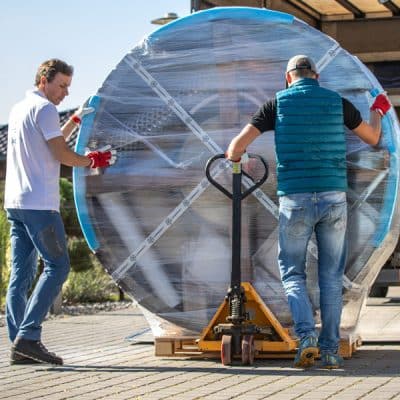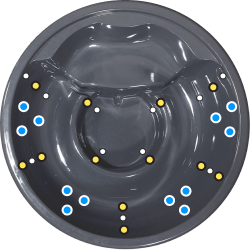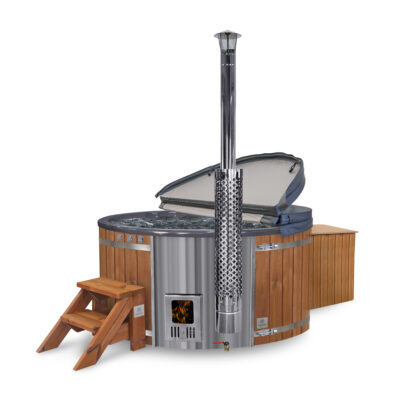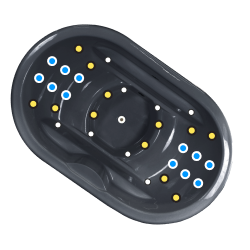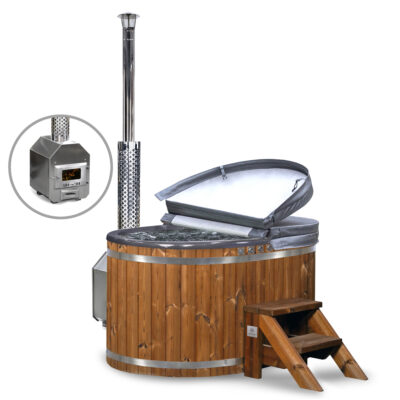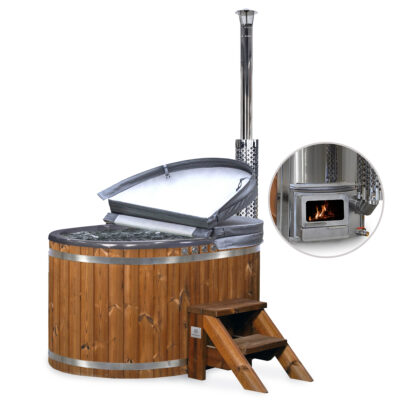To ensure perfect water clarity and efficiency, Gardenvity wood-fired hot tubs use sand filters with fibre balls as a standard. Sand filter has been the oldest water filtration system used in swimming pools, commonly using natural filtering media – hence their name.
The technology has been significantly improved by replacing sand with more effective modern filtering media, such as fibre balls to trap smaller particles (down to 5-3 microns compared to 35-20 microns with sand).
The modern filtering media also plays an important role in reducing energy consumption, keeping the filter pumps under lower pressure. What is more, the fibre balls can be recycled to make it an environmentally friendly solution.
This article will present the benefits of a sand filter filled with alternative fibre media for water filtering. Read a comparison article here if you find yourself sitting on the fence about using sand/fibre balls or a cartridge filter:
- The key benefits offered by a sand/fibre ball filter
- Fibre balls for your convenience: do they do the job well?
- How often do you have to change the water in a wood-fired hot tub?
- What should I know about the usage and maintenance of a sand/fibre ball filter?
- What are the expected maintenance and operation costs of this filter?
1. The key benefits offered by a sand/fibre ball filter
Our sand/fibre ball filter is designed to be used with lightweight and environmentally friendly fibre balls. We must make it clear that the type of sand filter used in our products cannot be used with sand for filtering the water – it’s a sand filter in name only. This type of filtration is preferred by users who value the long service life of the filtering media. The fibre balls used in a water filter serve 2 years. The maintenance work during those years involves nothing more than occasionally cleaning the fibre balls. You will not have to worry about buying filter cartridges regularly, as is the case when using cartridge filters.
Long service life.
Easy, low-cost maintenance.
Good performance, trapping impurities of 10-3 microns in size.
Environmentally friendly solution.
2. Fibre balls for your convenience: do they do the job well?
Using fibre balls instead of sand seems to be an all-around perfect solution for keeping the water clean in the hot tub because:
They capture debris and dirt effectively (down to 10 microns – or even to 5 or 3 microns, as some manufacturers claim).
They require little maintenance work – a simple hand wash or in a washing machine.
They are incredibly lightweight.
They reduce energy consumption.
They are environmentally and cost-friendly.
To answer the question if the filter balls clean the water in a hot tub effectively, it’s a YES, absolutely! Pool and hot tub owners report that they actually do a better job trapping debris and dirt while requiring less maintenance. Since the polyethylene fibre offers excellent porosity and does not clump or harden over time, the whole filtration cubic area is effectively employed to remove the particles from your hot tub water. It also means that the water flows more easily through the bed of filter balls, reducing the pressure needed from the filter pump (therefore, lowering energy consumption) and increasing the service life of the pump.
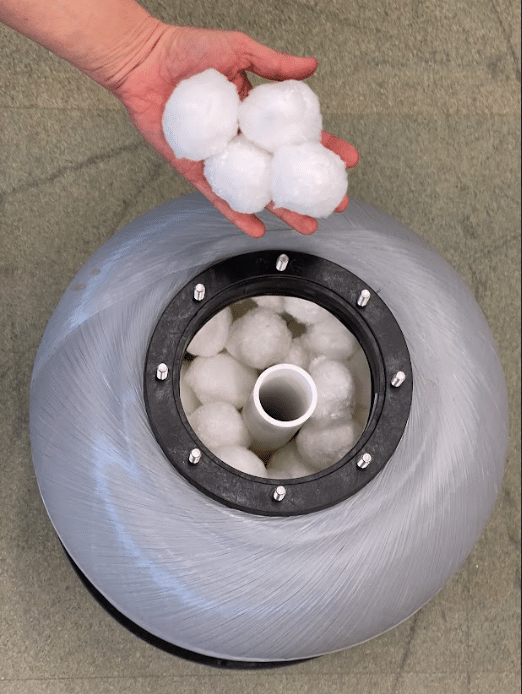
If you notice sediments on the hot tub bottom, this does not show failure in the filter performance. Simply switch the massage system on to move the particles with water, and the filter will trap those impurities.
Fibre filter balls have to be cleaned by taking them out to soak and wash manually or in a washing machine (please, put them in a washing net when doing so!). In both cases, filter balls are there to last a long time with very little wear. The good news is that the balls are recyclable after a few years of usage, making it a highly environmentally friendly solution.
500g of filter balls replace 18kg of sand, which in other words means that they are more than 30 times lighter, and thus, more practical for shipping and disposal.
Finally, filter balls are cheaper than the special sand used in water filtration. You can get filtration balls at most pool stores, e.g., on Amazon.
3. How often do you have to change the water in a wood-fired hot tub?
With the combination of sand/fibre ball filter, UV-C module and water sanitisers in the Gardenvity Premium wood-fired hot tubs, it is possible to keep the water in the hot tub for a few months. A water filter removes debris and a UV-C lamp and chemicals kill bacteria. You have to do both and follow the manufacturers’ instructions carefully for best results. Without water treatment, you should change the water in 1-2 days after 1-2 uses.
4. What should I know about the usage and maintenance of a sand/fibre ball filter?
As a standard, maintenance works with a sand/fibre ball filter includes the following:
Timely cleaning of fibre balls. Typically, you’d expect to see the pressure gauge needle going up, signalling you to backwash, but not with the fibre balls. We recommend that you inspect the fibre balls inside your filter every 3 months and clean them if needed. However, it will largely depend on usage and quality of the water. Use a little trial and error to find the best schedule for your hot tub. When you keep fibre balls clean, you’ll have better filtration, water flow and clearer water.
Cleaning the filter strainer to remove the larger debris restrained at the water pump inlet when you see it.
Changing fibre balls when they lose effectiveness. This has to be performed at least once in 2 years. This operation requires more work than, for example, replacing a cartridge, but it’s worth the effort due the environmental advantage of using recyclable fibre balls.
Please bear in mind that when using the sand/fibre ball filter to remove debris and particles, you still need water treatment chemicals to kill the bacteria.
As you can see, there are not so many points included in your maintenance schedule.

5. What are the expected maintenance and operation costs of this filter?
When you need to estimate the cost of maintenance and operation of the sand/fibre ball filter, you need to weigh in the replacement fibre balls and the electricity needed to power the filter motor. Here’s your summary:
Year 1 – none*
Year 2 – none*
Year 3 – fibre balls, £20
Year 4 – none*
Total in 4 years: £20
Power costs
Working at 250W power, based on current average electricity price in the UK (which is 34p/kWh in Q1 2023), the sand/fibre ball filter would consume £0.085 per operating hour. The water filter needs to be run 4-5 hours daily when the hot tub is filled with water. Thus, if your Gardenvity wood-fired hot tub is used all year-round, you’re looking at around £12.50 a month.
* You will only need to wash the fibre balls either by hand or in a washing machine (put them in a washing net when doing so!) every few months. This will cost a bit of your time, water and electricity – which is just minimal and hard to convert into specific amount of pounds.
To sum it all up, a sand filter for water cleaning in a hot tub is meant for those who value long service life, quality performance, and ease of maintenance. Combined with the modern sand alternative – filter balls – the care is easier with fewer pounds to carry home and less strain on the environment since the polyester balls are fully recyclable.
Check our other articles for more practical tips and advice on the usage and maintenance of the sand filter in a Gardenvity wood-fired hot tub.
Happy hot-tubbing!
